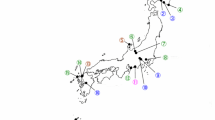Abstract
The phylogenetic relationship of a nonflagellated, Gram-negative, rod-shaped intracellular bacterial parasite (BEV) of the leafhopperEuscelidius variegatus to other bacteria within the classProteobacteria was determined by sequence analysis of 16S rDNAs. The presence of specific signature nucleotides showed this bacterium to be a member of the γ-3 subdivision of theProteobacteria. Phylogenetic analysis based on maximum parsimony placed BEV within a clade in theEnterobacteriaceae, which includes a number of bacteria that are facultative symbiotes of insects and have a common ancestor withProteus vulgaris. Within this clade, BEV is most closely related to a bacterium identified as the secondary endosymbiote of another homopteran, the pea aphid,Acyrthosiphon pisum.
Similar content being viewed by others
Literature Cited
Brosius J, Dull TJ, Sleeter D, Noller HF (1981) Gene organization and primary structure of a ribosomal RNA operon fromEscherichia coli. J Mol Biol 148:107–127
Buchner P (1965) Endosymbiosis of animals with plant micro-organisms. New York: J Wiley & Sons
Campbell BC (1990) On the role of microbial symbiotes in herbivorous insects. In: Bernays EA (ed) Insect-plant interactions, vol. I. Boca Raton, Fla: CRC Press, Inc., pp 1–44
Campbell BC, Bragg TS, Turner CE (1992) Phylogeny of symbiotic bacteria of four weevil species (Coleoptera: Curculionidae) based on analysis of 16S ribosomal DNA. Insect Biochem Mol Biol 22:415–421
Clark MA, Baumann L, Munson MA, Baumann P, Campbell BC, Duffus JE, Osborne LS, Moran NA (1992) The eubacterial endosymbionts of whiteflies (Homoptera: Aleyrodoidea) constitute a lineage distinct from the endosymbionts of aphids and mealybugs. Curr Microbiol 25:119–125
Fox GE, Wisotzkey JD, Jurtshuk P (1992) How close is close: 16S rRNA sequence identity may not be sufficient to guarantee species identity. Int J Syst Bacteriol 42:166–170
Gherma RL, Werren JH, Weisburg W Cote R, Woese CR, Mandelco L, Brenner DJ (1991)Arsenophonus nasoniae gen. nov., sp. nov., the causative agent of the son-killer trait in the parasitic waspNasonia vitripennis. Int J Syst Bacteriol 41:563–565
Giannotti J (1969) Transmission of clover phyllody by a new leafhopper vector,Euscelidius variegatus. Plant Dis Rep 53:173
Hamilton KGA (1983) Introduced and native leafhoppers common to the old and new worlds (Rhyncota: Homoptera: Cicadellidae). Can Entomol 115:473–511
Houk EJ, Griffiths GW (1980) Intracellular symbiotes of the Homoptera. Annu Rev Entomol 25:161–187
Jensen DD (1969) Comparative transmission of western X-disease virus byColladonus montanus, C. geminatus, and a new leafhopper vector,Euscelidius variegatus. J Econ Entomol 62:1147–1150
Lipman DJ, Pearson WR (1985) Rapid and sensitive protein similarity searches. Science 227:1435–1441
Markham PG, Townsend R (1979) Experimental vectors of spiroplasmas. In: Maramorosch K, Harris KF (eds) Leafhopper vectors and plant disease agents. New York: Academic Press, pp 413–445
Munson MA, Baumann P Kinsey MG. (1991a)Buchnera gen. nov. andBuchnera aphidicola sp. nov., a taxon consisting of the mycetocyte-associated, primary endosymbionts of aphids. Int J Syst Bacteriol 41:566–568
Munson MA, Baumann P, Clark MA, Baumann L, Moran NA, Voegtlin DJ, Campbell BC (1991b) Evidence for the establishment of aphid-eubacterium endosymbiosis in an ancestor of four aphid families. J Bacteriol 173:6321–6324
Munson MA, Baumann P, Moran NA (1992) Phylogenetic relationships of the endosymbionts of mealybugs (Homoptera: Pseudococcidae) based on 16S rDNA sequences. Mol Phylogen Evol 1:26–30
Neefs J-M, Van de Peer Y, Hendriks L, De Wachter R (1990) Compilation of small ribosomal subunit RNA sequences. Nucleic Acids Res 18:r2237-r2317
Purcell AH, Suslow KG (1987) Pathogenicity and effects on transmission of a mycoplasmalike organism of a transovarially inffective bacterium on the leafhopperEuscelidius variegatus (Homoptera: Cicadellidae). J Invert Pathol 50:285–290
Purcell AH, Steiner T, Mégraud F, Bové J (1986) In vitro isolation of a transovarially transmitted bacterium from the leafhopperEuscelidius variegatus (Hemiptera: Cicadellidae). J Invert Pathol 48:66–73
Saiki RK, Gelfand DH, Stoffel S, Scharf SJ, Higuchi R, Horn GT, Mullis KB, Erlich HA (1988) Primer-directed enzymatic amplification of DNA with a thermostable DNA polymerase. Science 239:487–491
Sambrook J, Fritsch EF, Maniatis T (1989) Molecular cloning; a laboratory manual, 2nd edn. Cold Spring Harbor, N.Y.: Cold Spring Harbor Laboratory Press
Severin HH (1947) Newly discovered leafhopper vectors of California aster-yellows virus. Hilgardia 17:511–523
Swofford DL (1991) PAUP: phylogenetic analysis using parsimony. ver. 3.0r for the Macintosh. Champaign: Illinois Natural History Survey
Tiivel T. (1989) Leafhopper endocytobiosis. In: Schwemmler W (ed) CRC handbook of insect endocytobiosis: morphology, physiology, genetics, evolution. Boca Raton, Fla: CRC Press, Inc.
Unterman BM, Baumann P, McLean DL (1989) Pea aphid symbiont relationships established by analysis of 16S rRNAs. J Bacteriol 171:2970–2974
Weisburg WF, Dobson ME, Samuel JE, Dasch GA, Mallavia LP, Baca O, Mandelco L, Sechrest JE, Weiss E, Woese CR (1989) Phylogenetic diversity of theRickettsiae. J Bacteriol 171:4202–4206
Woese CR (1987) Bacterial evolution. Microbiol Rev 51:221–271
Woese CR, Weisburg WG, Hahn CM, Paster BJ, Zablen LB, Lewis BJ, Macke TJ, Ludwig W, Stackebrandt E (1985) The phylogeny of purple bacteria: the gamma subdivision. Syst Appl Microbiol 6:25–33
Author information
Authors and Affiliations
Rights and permissions
About this article
Cite this article
Campbell, B.C., Purcell, A.H. Phylogenetic affiliation of BEV, a bacterial parasite of the leafhopperEuscelidius variegatus, on the basis of 16S rDNA sequences. Current Microbiology 26, 37–41 (1993). https://doi.org/10.1007/BF01577240
Issue Date:
DOI: https://doi.org/10.1007/BF01577240




